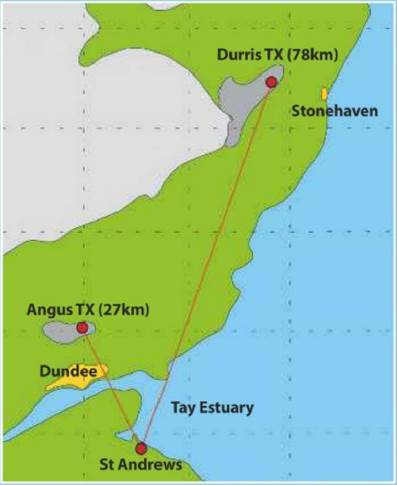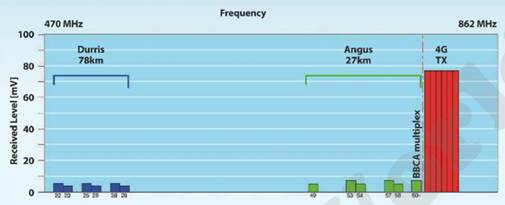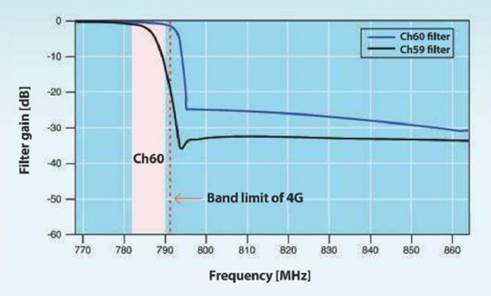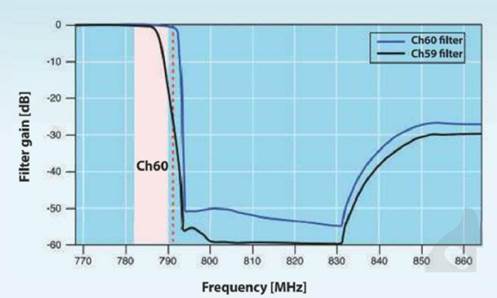Personal encounter
Probably the simplest way to illustrate the
kind of interference problems that millions of viewers may encounter as a
result of the 4G plan is to use a specific example – my own!
The map shows where I live relative to the
two closest DTTV transmitter sites. At present I get adequate signals from both
transmitters. Although there is no local 4G coverage as yet, the closet
existing mobile base station to my house is about 400 meters away, in the same
direction as Angus.
The documents published over the last year
or two regarding 4G propose base station EIRPs from 59 dBm/10MHz up to 64
dBm/10MHz. for the sake of example I chose a value of 0-5 kW for each 5 MHz 4G
channel. In practice it is now set at just over 1kW for each 5MHz 4G base
station channel.

Personal
encounter
By the end of October 2013 the ‘4G
clearance’ should be complete. At that point any DTTV broadcasts that were
previously being transmitted above ch60 will have been shifted down to lower
frequencies. For Angus the result I can expect using a fairly typical TV aerial
will look like the spectrum shown below. Note that the BBCA multiplex is
planned to be adjacent to the 4G base station transmissions and use ‘Ch60-’.
This multiplex is important as it carries all the main BBC stations – BBC1,
BBC2, etc.
The TV multiplexes from Angus and Durris
each give me signal levels on the antenna down-lead somewhere between about 3
mV and 6 mV. Whereas a 4G base station placed at the local mobile phone site
would produce about 78 mV for each 4G downlink channel.i.e. each 4G channels is
over 20dB more powerful than the wanted DTTV multiplexes. Given six 4G downlink
channels the actual combined voltage they will produce on average will be
around 200 mV!
Anyone familiar with the design and
behavior of domestic TV sets, boxes, etc, will realize that this level of input
is alarmingly high. It is likely to overload the distribution amplifier I use,
and probably stop me watching DTTV unless I can cut down the 4G interference
level. From this example I can expect many people within 500 meters of a base
station to lose DTTV entirely!

Spectrum
be the end of 2013
Filter effects
The Ofcom report “Technical Analysis of
Interference form Mobile Phone Base Station in the 800 MHz Band to DTTV –
Further Modeling” (published February 23, 2012) examines four different filter
designs for reducing 4G interference. Two of the filters were aimed at being
suitable for use with normal domestic DTTV receivers. The other two were aimed
at Communal Antenna Systems (CAS) before the preamplifier/distribution systems.
The graphs below show the gain-frequency
profilers taken from the two filters designed for use with household DTTV sets
and set-top boxes. Two filters were considered because the planned continued
use of ch60 poses a serious challenge to making satisfactory filters that can
be afforded. Strictly speaking, the intent is that DTTV in this channel may
actually be nudged down to ‘ch60-’. However this only represents a downshift of
166 kHz. It seems doubtful this minor tweak will provide much improvement in 4G
rejection.

Domestic
DTTV RX filters
The root of the problem by continued use of
ch60/60- is that it demands a filter that can transit from passing signals to
rejecting them in a very narrow transition range. The graphs below illustrate
the difficulties when we compare the two designs. The ‘ch60 filter’ is aimed at
situations where ch60 is being used. This means it has to pass the ch60 DTTV
signals with low loss and avoid excess tilt in amplitude or phase across the
channel that would, itself, degrade the receiver’s ability to operate. Since
the LF end of the 4G band is only about 1 MHz away, the result is poor 4G
rejection for frequencies in the lowest few MHz of the 4G band. It also leads
to relatively poor rejection across the rest of the 4G band. Even well into the
4G band the rejection is only in the range from 25dB to 30dB. The example used
earlier as an illustration of the situation that may be common, produced a 4G
level from the domestic DTTV antenna in the range between 100 mV and 200 mV. In
such cases the ‘ch60’ would reduce this to being 3 to 10 mV. Given a domestic
DTTV RX that rejects efficiently, a DTTV output from the domestic antenna
around 3-5 mV may allow satisfactory reception. However, it is worth reminding
ourselves that this example is one where the DTTV RX system is 400 meters from
the 4G base station radiating the (assumed) challenge.
If you happen to be living in a location
where DTTV does not require the use of ch60/60- the situation improves. This
can be seen by considering the ‘ch59 filter’ which is a design aimed at being
implemented in such circumstances.
Because this filter does not need to ensure
that it passes ch60/60- it can employ a wider transition and achieves around
35dB of rejection, being around 25dB even at the LF edge of the 4G band. This
would effectively cut the above down to around 1.5 – 3 mV, which may well be a
useful improvement in many cases.

CAS
filters
The CAS filters graph (below, right) shows
the results for the second type of filter considered. This is aimed at communal
systems. It has a markedly better performance than the ‘domestic’ type. I
assume that argument here is that a communal system can be more costly because
the price is spread across a number of households. However it is worth noting
at this point that many ‘non-communal’ households these days employ a
distribution amplifier. This is typically somewhere like in the loft. These add
an extra layer that may require protection form 4G signals. Otherwise they may
generate intermodulation that makes it harder for the following RX to read the
wanted DTTV modulation. Given this, it may be worth wondering if filters to the
above ‘CAS’ standard may be required in some or many single-household
dwellings. As with the domestic filters. Though, it can be seen that being able
to sacrifice ch60 provides a clear improvement in filter performance.